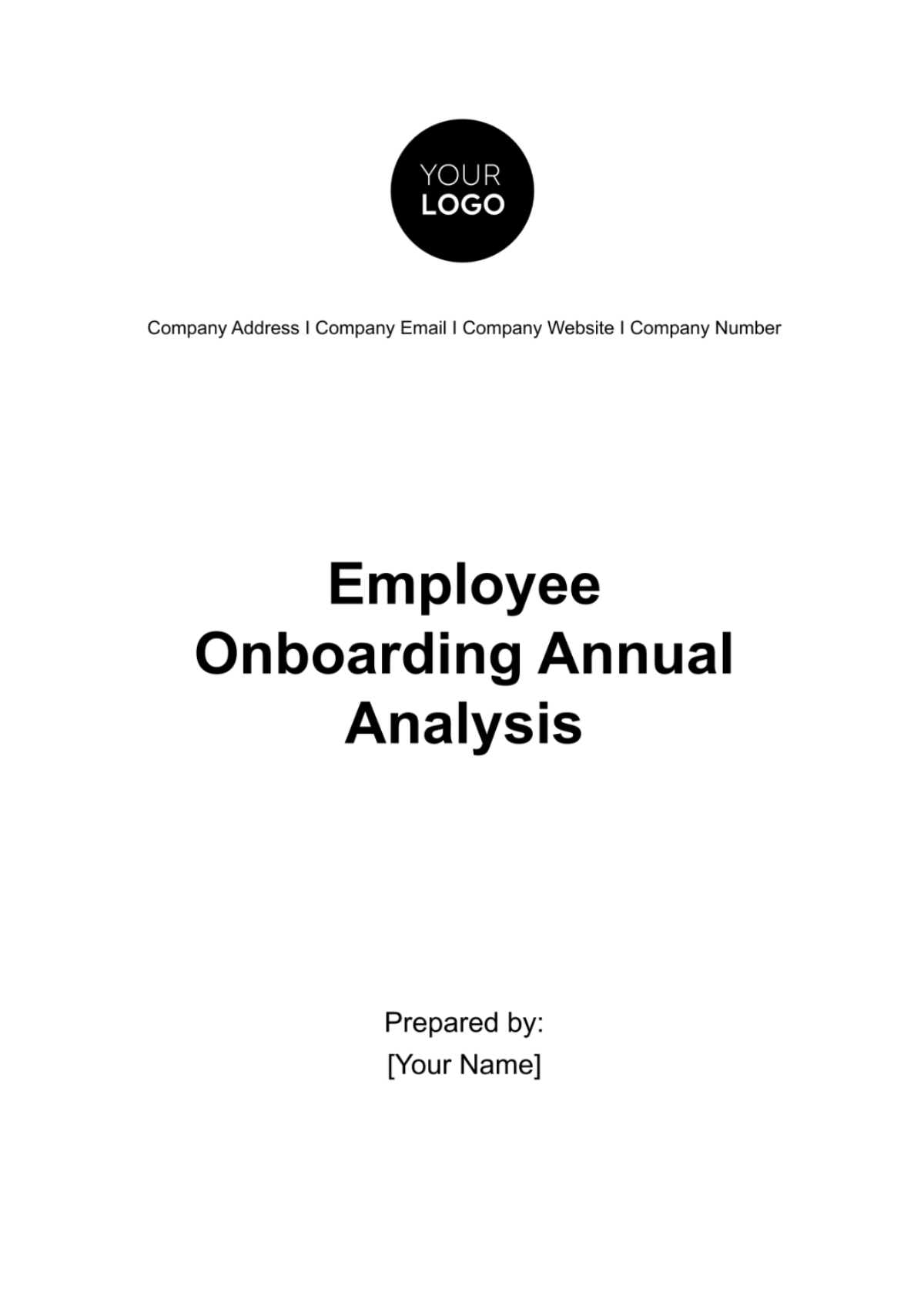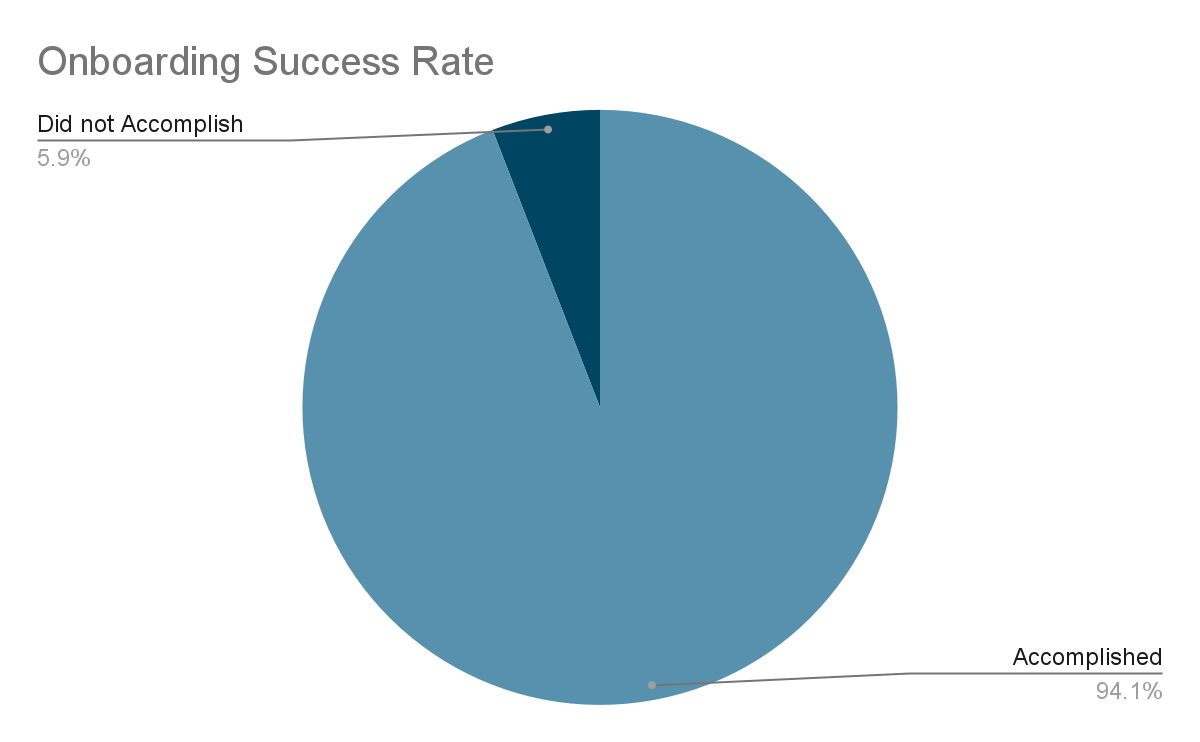Free Employee Onboarding Annual Analysis HR

Executive Summary
In the year [Year], our organization welcomed a total of [x] new employees, spanning various departments, setting the stage for another year of growth and innovation. This annual analysis report serves as a comprehensive snapshot of our employee onboarding process's performance, meticulously dissecting key metrics and achievements while providing a roadmap for the future. Notably, our onboarding completion rate stood at an impressive [x]%, a testament to our dedication to guiding new hires successfully into their roles. Our average time-to-productivity of just [x] days reaffirms the efficiency of our onboarding process, underscoring our commitment to maximizing the early contributions of new team members.
In parallel, our employee retention rate reached [x]%, demonstrating the staying power of talent nurtured through our onboarding process. Further fueling our pride, employee satisfaction surveys revealed a remarkable [x]% satisfaction rate among new hires, reflecting our commitment to delivering an outstanding onboarding experience. Manager feedback, with a satisfaction rate of [x]%, underscores the strategic role of managers in our onboarding process. This Executive Summary encapsulates our year of achievement, highlighting not only our successes but also areas for improvement, paving the way for our strategic goals in [Year].
Introduction
Effective onboarding remains critical to employee engagement, retention, and overall organizational success. This report meticulously examines key metrics and insights from our employee onboarding process in [Year]. Its primary objective is to assess the effectiveness of our onboarding initiatives and offer recommendations for enhancing the experience for our new hires.
Onboarding Metrics
Onboarding Completion Rate
In [Year], our organization achieved an impressive Onboarding Completion Rate of [x]%. This rate signifies the percentage of new hires who successfully completed the onboarding process during the year. As depicted in the graph above, this achievement showcases our dedication to guiding new employees through the comprehensive onboarding journey, ensuring they are well-prepared to contribute to the organization effectively. With [x]% of new hires completing the process, we have demonstrated our commitment to providing the necessary tools and resources for a successful integration into our workforce. This graph clearly illustrates the strong success we have achieved in this crucial aspect of our onboarding process.
Figure 1: Pie Graph on the Completion Rate of the Onboarding
Time-to-Productivity
In [Year], our new employees reached full productivity within an average of just [x] days. This rapid integration into their roles is a testament to the efficiency and effectiveness of our onboarding process. By minimizing the time it takes for new hires to become productive contributors, we not only enhance their job satisfaction but also maximize their value to the organization from an early stage.
Employee Retention
One of the significant outcomes of our effective onboarding process in [Year] was an outstanding Employee Retention Rate of [x]%. As depicted in the graph, this rate represents the percentage of employees who remained with the organization after completing the onboarding process. It is clear from the graph that our approach to onboarding has had a substantial impact on retaining valuable talent. A high retention rate not only signifies a stable and committed workforce but also leads to cost savings associated with reduced turnover. The graph emphasizes the importance of our onboarding process in creating an environment where employees feel valued and motivated to stay and grow with the organization.
Figure 2: Pie Graph on the Employee Retention of New Employees
Feedback and Surveys
New Hire Satisfaction
New Hire Satisfaction is a pivotal aspect of our onboarding process, and in [Year], we achieved an exceptional Satisfaction Rate of [x]%. The graph vividly illustrates the overwhelmingly positive feedback received from our new hires, showcasing their high levels of satisfaction with the onboarding experience. This level of satisfaction reflects our commitment to delivering an outstanding onboarding journey that aligns with the needs and expectations of our new employees. A satisfied new hire is more likely to be engaged, productive, and committed to the organization, as reflected in the graph's data.
Figure 3: Pie Graph on New Hire Satisfaction
Manager Feedback
Manager Feedback plays a crucial role in shaping our onboarding process, as highlighted in the graph above. In [Year], manager feedback indicated a remarkable [x]% satisfaction rate with the onboarding process. The graph provides a visual representation of the satisfaction levels reported by managers, demonstrating the positive impact of our onboarding process on teams and organizational productivity. Managers play a key role in supporting new employees' integration, and their satisfaction reflects the effectiveness of our onboarding process in ensuring a seamless transition. This graph underscores the importance of involving managers in the onboarding journey and the significant value they find in our approach.
Figure 4: Manager’s Satisfaction Rate of the Onboarding Process
Areas for Improvement
Onboarding Duration
The average duration of our onboarding process in [Year] was a highly efficient [x] days. This streamlined process allows us to integrate new employees quickly while maintaining the quality and effectiveness of their onboarding experience. As we continue to explore opportunities for improvement, we aim to make the onboarding duration even more efficient without compromising its impact.
Training Material Updates
In [Year], some employees noted outdated training materials in their feedback. This feedback highlights the importance of regularly updating our training materials to ensure that new hires receive the most current and relevant information. By keeping our training materials up-to-date, we can better equip our new employees to succeed in their roles.
Best Practices
Mentorship Programs
The introduction of mentorship programs in [Year] had a positive impact on new hire integration. These programs provided valuable guidance and support to new employees, helping them navigate their roles and adapt to our organizational culture more smoothly. As we expand and enhance these mentorship initiatives, we anticipate even more significant benefits in terms of employee engagement and retention.
Personalized Onboarding Plans
In [Year], the introduction of customized onboarding plans resulted in favorable outcomes. Tailoring the onboarding experience to individual needs and roles allowed us to engage new employees more effectively. As we continue to prioritize personalized onboarding plans, we expect to further enhance employee engagement and retention rates.
Strategic Goals for [Year]
Enhanced Digital Onboarding
Our strategic goal for [Year] is to implement an improved digital onboarding platform. This initiative aims to streamline processes and enhance the overall new hire experience by leveraging technology. By investing in this digital solution, we anticipate increased efficiency, reduced administrative burden, and a more engaging onboarding process for our new employees.
Onboarding Analytics
In [Year], we plan to invest in advanced analytics tools to gain deeper insights into the onboarding process. These tools will allow us to track key performance metrics more comprehensively, identify areas for improvement, and make data-driven decisions to enhance our onboarding program continuously. With the power of analytics, we aim to further optimize our onboarding process and provide an even more seamless experience for new hires.
Diversity and Inclusion Integration
Our commitment to diversity and inclusion will be further solidified in [Year] by integrating diversity and inclusion training into the onboarding process. This initiative aligns with our organizational values and goals and underscores our dedication to fostering an inclusive workplace. By ensuring that diversity and inclusion are central components of our onboarding experience, we aim to create a more equitable and welcoming environment for all new employees.
Employee Feedback and Continuous Improvement
Employee Feedback
The feedback we received from new employees highlighted several strengths of our onboarding process, including the clarity of expectations, the quality of training materials, and the effectiveness of mentorship programs. Additionally, it pinpointed areas where we can further improve, such as offering more specialized training options to accommodate various roles and refining communication during the onboarding journey.
Actionable Improvements
This feedback-driven approach has informed our strategic goals for 2052 and beyond. We are committed to implementing changes based on this input to create an even more seamless and engaging onboarding experience. By continuously integrating employee feedback, we ensure that our onboarding process evolves to meet the ever-changing demands of our workforce, fostering engagement and contributing to long-term success.
Iterative Improvement
By gathering feedback in real-time, we can iterate and adjust the onboarding process dynamically, ensuring that it remains responsive to the evolving needs and expectations of our new employees. This approach will further solidify our commitment to continuous improvement, making our onboarding process not just effective but also adaptive and tailored to the unique experiences of each new hire.
Conclusion
In conclusion, the comprehensive analysis of our employee onboarding process in [Year] paints a portrait of success and opportunities for growth. We have demonstrated a commitment to excellence through a [x]% onboarding completion rate and an efficient [x]-day time-to-productivity. This speaks volumes about our ability to onboard new employees effectively, setting them on a path to becoming valuable contributors. Furthermore, with an [x]% retention rate, it is evident that our onboarding process plays a pivotal role in fostering long-term engagement and loyalty among our employees.
Looking ahead to [Year], we have charted a strategic course aimed at enhancing our onboarding process. Our commitment to continuous improvement includes implementing an advanced digital onboarding platform, leveraging analytics for insights, and integrating diversity and inclusion training. These initiatives align with our vision of providing a world-class onboarding experience, ensuring that each new employee is not just onboarded but welcomed, supported, and empowered to thrive from their very first day. We remain steadfast in our dedication to excellence and look forward to another year of growth, learning, and innovation.
- 100% Customizable, free editor
- Access 1 Million+ Templates, photo’s & graphics
- Download or share as a template
- Click and replace photos, graphics, text, backgrounds
- Resize, crop, AI write & more
- Access advanced editor
Streamline your onboarding process with oTemplate.net's Employee Onboarding Annual Analysis HR Template. Editable and customizable, it offers comprehensive insights into onboarding effectiveness. Accessible through our online AI Editor Tool, tailor it to your company's needs effortlessly. Elevate your HR practices and optimize employee integration for long-term success.





























